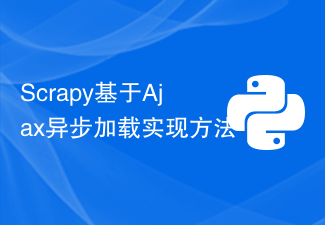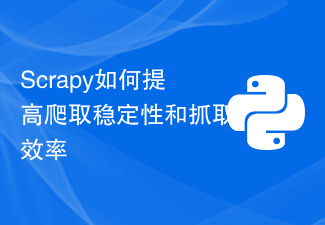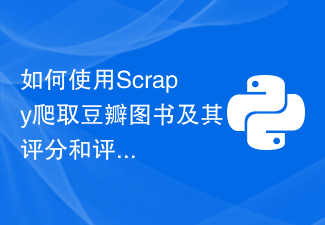 Backend Development
Backend Development Python Tutorial
Python Tutorial Building a crawler environment: Scrapy installation guide step by step
Building a crawler environment: Scrapy installation guide step by step
Scrapy installation tutorial: teach you step by step to build a crawler environment, specific code examples are required
Introduction:
With the rapid development of the Internet, data mining and information The demand for collection is also increasing. As a powerful data collection tool, crawlers are widely used in various fields. Scrapy, as a powerful and flexible crawler framework, is favored by many developers. This article will teach you step by step how to set up a Scrapy crawler environment, and attach specific code examples.
Step one: Install Python and PIP tools
Scrapy is written in Python language, so before using Scrapy, we need to install the Python environment first. The Python version for your operating system can be downloaded and installed from the official Python website (https://www.python.org). After the installation is complete, you also need to configure Python's environment variables to facilitate running Python directly on the command line.
After installing Python, we need to install PIP (Python's package management tool) for subsequent installation of Scrapy and its related dependent libraries. Enter the following command on the command line to install the PIP tool:
$ python get-pip.py
Step 2: Install Scrapy
Before installing Scrapy, we need to install some Scrapy dependency libraries. Enter the following command on the command line to install these dependent libraries:
$ pip install twisted $ pip install cryptography $ pip install pyOpenSSL $ pip install queuelib $ pip install lxml
After installing these dependent libraries, we can use PIP to install Scrapy. Enter the following command on the command line to install Scrapy:
$ pip install scrapy
Step 3: Create a new Scrapy project
After installing Scrapy, we can create a new Scrapy project. Enter the following command at the command line to create a new Scrapy project:
$ scrapy startproject myproject
This will create a directory named "myproject" in the current directory, which contains a basic Scrapy project structure.
Step 4: Write a crawler
In the new Scrapy project, we need to write a crawler to implement specific data collection functions. Go to the "myproject" directory on the command line, and then enter the following command to create a new crawler:
$ scrapy genspider example example.com
This will create a crawler named "example" in the "myproject/spiders/" directory document.
In the crawler file, we can write specific data collection code. The following is a simple example:
import scrapy
class MySpider(scrapy.Spider):
name = 'example'
allowed_domains = ['example.com']
start_urls = ['http://www.example.com']
def parse(self, response):
# 在这里编写你的数据采集逻辑
passIn the above example, we defined a crawler class named "example" and specified the target website and starting URL to be collected. In the parse method, we can write specific collection logic and use various functions provided by Scrapy to parse web pages, extract data, etc.
Step 5: Run the crawler
After writing the crawler, we can run the crawler on the command line. Enter the "myproject" directory and enter the following command to run the crawler:
$ scrapy crawl example
where "example" is the name of the crawler to be run. Scrapy will download web pages and extract data based on the logic defined by the crawler. At the same time, it will also automatically handle a series of operations such as redirection, user login, and cookies, greatly simplifying the data collection process.
Conclusion:
Through the above steps, we can build a simple and powerful crawler environment and use Scrapy to implement various data collection tasks. Of course, Scrapy has more functions and features, such as distributed crawlers, dynamic web crawling, etc., which are worthy of further learning and exploration. I hope this article is helpful to you, and I wish you good luck in your crawler journey!
The above is the detailed content of Building a crawler environment: Scrapy installation guide step by step. For more information, please follow other related articles on the PHP Chinese website!
 Scrapy实现微信公众号文章爬取和分析Jun 22, 2023 am 09:41 AM
Scrapy实现微信公众号文章爬取和分析Jun 22, 2023 am 09:41 AMScrapy实现微信公众号文章爬取和分析微信是近年来备受欢迎的社交媒体应用,在其中运营的公众号也扮演着非常重要的角色。众所周知,微信公众号是一个信息和知识的海洋,因为其中每个公众号都可以发布文章、图文消息等信息。这些信息可以被广泛地应用在很多领域中,比如媒体报道、学术研究等。那么,本篇文章将介绍如何使用Scrapy框架来实现微信公众号文章的爬取和分析。Scr
 Scrapy基于Ajax异步加载实现方法Jun 22, 2023 pm 11:09 PM
Scrapy基于Ajax异步加载实现方法Jun 22, 2023 pm 11:09 PMScrapy是一个开源的Python爬虫框架,它可以快速高效地从网站上获取数据。然而,很多网站采用了Ajax异步加载技术,使得Scrapy无法直接获取数据。本文将介绍基于Ajax异步加载的Scrapy实现方法。一、Ajax异步加载原理Ajax异步加载:在传统的页面加载方式中,浏览器发送请求到服务器后,必须等待服务器返回响应并将页面全部加载完毕才能进行下一步操
 Scrapy优化技巧:如何减少重复URL的爬取,提高效率Jun 22, 2023 pm 01:57 PM
Scrapy优化技巧:如何减少重复URL的爬取,提高效率Jun 22, 2023 pm 01:57 PMScrapy是一个功能强大的Python爬虫框架,可以用于从互联网上获取大量的数据。但是,在进行Scrapy开发时,经常会遇到重复URL的爬取问题,这会浪费大量的时间和资源,影响效率。本文将介绍一些Scrapy优化技巧,以减少重复URL的爬取,提高Scrapy爬虫的效率。一、使用start_urls和allowed_domains属性在Scrapy爬虫中,可
 深度使用Scrapy:如何爬取HTML、XML、JSON数据?Jun 22, 2023 pm 05:58 PM
深度使用Scrapy:如何爬取HTML、XML、JSON数据?Jun 22, 2023 pm 05:58 PMScrapy是一款强大的Python爬虫框架,可以帮助我们快速、灵活地获取互联网上的数据。在实际爬取过程中,我们会经常遇到HTML、XML、JSON等各种数据格式。在这篇文章中,我们将介绍如何使用Scrapy分别爬取这三种数据格式的方法。一、爬取HTML数据创建Scrapy项目首先,我们需要创建一个Scrapy项目。打开命令行,输入以下命令:scrapys
 在Scrapy爬虫中使用Selenium和PhantomJSJun 22, 2023 pm 06:03 PM
在Scrapy爬虫中使用Selenium和PhantomJSJun 22, 2023 pm 06:03 PM在Scrapy爬虫中使用Selenium和PhantomJSScrapy是Python下的一个优秀的网络爬虫框架,已经被广泛应用于各个领域中的数据采集和处理。在爬虫的实现中,有时候需要模拟浏览器操作去获取某些网站呈现的内容,这时候就需要用到Selenium和PhantomJS。Selenium是模拟人类对浏览器的操作,让我们可以自动化地进行Web应用程序测试
 Scrapy爬虫实践:爬取QQ空间数据进行社交网络分析Jun 22, 2023 pm 02:37 PM
Scrapy爬虫实践:爬取QQ空间数据进行社交网络分析Jun 22, 2023 pm 02:37 PM近年来,人们对社交网络分析的需求越来越高。而QQ空间又是中国最大的社交网络之一,其数据的爬取和分析对于社交网络研究来说尤为重要。本文将介绍如何使用Scrapy框架来爬取QQ空间数据,并进行社交网络分析。一、Scrapy介绍Scrapy是一个基于Python的开源Web爬取框架,它可以帮助我们快速高效地通过Spider机制采集网站数据,并对其进行处理和保存。S
 Scrapy如何提高爬取稳定性和抓取效率Jun 23, 2023 am 08:38 AM
Scrapy如何提高爬取稳定性和抓取效率Jun 23, 2023 am 08:38 AMScrapy是一款Python编写的强大的网络爬虫框架,它可以帮助用户从互联网上快速、高效地抓取所需的信息。然而,在使用Scrapy进行爬取的过程中,往往会遇到一些问题,例如抓取失败、数据不完整或爬取速度慢等情况,这些问题都会影响到爬虫的效率和稳定性。因此,本文将探讨Scrapy如何提高爬取稳定性和抓取效率。设置请求头和User-Agent在进行网络爬取时,
 如何使用Scrapy爬取豆瓣图书及其评分和评论?Jun 22, 2023 am 10:21 AM
如何使用Scrapy爬取豆瓣图书及其评分和评论?Jun 22, 2023 am 10:21 AM随着互联网的发展,人们越来越依赖于网络来获取信息。而对于图书爱好者而言,豆瓣图书已经成为了一个不可或缺的平台。并且,豆瓣图书也提供了丰富的图书评分和评论,使读者能够更加全面地了解一本图书。但是,手动获取这些信息无异于大海捞针,这时候,我们可以借助Scrapy工具进行数据爬取。Scrapy是一个基于Python的开源网络爬虫框架,它可以帮助我们高效地


Hot AI Tools

Undresser.AI Undress
AI-powered app for creating realistic nude photos

AI Clothes Remover
Online AI tool for removing clothes from photos.

Undress AI Tool
Undress images for free

Clothoff.io
AI clothes remover

AI Hentai Generator
Generate AI Hentai for free.

Hot Article

Hot Tools

EditPlus Chinese cracked version
Small size, syntax highlighting, does not support code prompt function

Safe Exam Browser
Safe Exam Browser is a secure browser environment for taking online exams securely. This software turns any computer into a secure workstation. It controls access to any utility and prevents students from using unauthorized resources.

Dreamweaver CS6
Visual web development tools

SublimeText3 Linux new version
SublimeText3 Linux latest version

mPDF
mPDF is a PHP library that can generate PDF files from UTF-8 encoded HTML. The original author, Ian Back, wrote mPDF to output PDF files "on the fly" from his website and handle different languages. It is slower than original scripts like HTML2FPDF and produces larger files when using Unicode fonts, but supports CSS styles etc. and has a lot of enhancements. Supports almost all languages, including RTL (Arabic and Hebrew) and CJK (Chinese, Japanese and Korean). Supports nested block-level elements (such as P, DIV),





